Every day, every hour, minute, and second, our world consumes trillions of bytes of data. And financial organizations are top performers in that! Market quotes, payments, settlements, portfolio holdings, client profiles, finance, and metrics – virtually every decision and process in W&A relies on data. Firms collect and consume more data than ever before. And from more sources.
It’s common for an asset manager to pull market and securities data from Bloomberg or Refinitiv, fund analytics from Morningstar, economic insights from dedicated research firms like BMI or Oxford Economics, and internal transaction records from Mergermarket, CapitalIQ, and Pitchbook all at once. This mix of multiple data providers creates a complex mosaic that organizations must piece together daily. As Deloitte observes, innovations and products are “increasing data volumes and complexity, making it harder to manage, maintain, and mine data.”

The need for high-quality data has never been more pressing as wealth managers expand globally and add digital investing capabilities. The proliferation of data is both an opportunity and a burden. Leading firms recognize that effective data management is a strategic differentiator, not just an IT concern.
Over 90% of asset managers worldwide are currently utilizing a wide range of data technologies to improve investment performance. Today, Sombra aims to share our insights on how to use these technologies more effectively, beneficially, and with higher quality. Step by step.
Step 1: High-Quality Data as a Basis
Recall the well-known adage: “Garbage in, garbage out.” It means the quality of decisions is only as good as the quality of the data behind them. For wealth and asset managers, accurate, high-quality data is absolutely vital for sound investment decisions. If the data feeding these analyses is wrong or inconsistent, the resulting insights and decisions will be flawed. This can lead to mispriced investments, misallocation of capital, and missed opportunities for both the firm and its clients.

You’re probably thinking we’re stating the obvious. But here’s the catch: 66% of banks still struggle with data quality and integrity issues, from missing key data points to incomplete transaction flows. Poor data is actively limiting the impact of AI analytics, causing firms to miss real opportunities for efficiency and performance gains.
Companies lose millions due to poor data quality. That includes inappropriate trades, inaccurate reporting, and millions lost due to simple reference errors that go unnoticed until audits expose them or companies face huge fines from regulators.
Finally, poor quality leads to reputational risks. Just look at Equifax’s 2022 credit score fiasco. One glitch led to millions of incorrect credit scores, denied loans, a stock drop, and a class-action lawsuit. Imagine a wealth manager misreporting client portfolio values or failing to execute trades on time. The damage to trust is hard to repair.
As one data governance leader bluntly put it: “Inaccurate data can lead to costly mistakes, regulatory fines, and reputational damage”. We’ve seen it happen. And we’ve helped fix it.

Where should you start with data quality?
Modern data architectures and consolidated data platforms enable teams to access a “single source of truth” across the organization. Another crucial step is applying data validation and cleansing techniques at every stage of the data pipeline. The priority is to optimize your data toolkit to ensure quality at the source. From AI-assisted screening tools to internal transaction records, each input must be validated for completeness and accuracy.
Fragmented systems also remain a barrier. To solve this, firms are increasingly investing in master data management and centralized governance. This not only enhances data usability but also strengthens internal controls and compliance.
Moreover, W&A organizations are aligning data quality initiatives with their business outcomes. As one Deloitte report puts it, managing data as an asset is now critical to success, as its availability, accessibility, and accuracy directly influence business models in wealth management.
When executed well, these actions lead to what we all love the most – smarter, faster investment decisions; reduced operational risks; lower costs; and stronger client confidence.
In short, clean data is the launchpad for everything that follows. At Sombra, we help companies eliminate silos, streamline pipelines, and establish effective data ownership. For compliance, reporting, and even decision-making, quality data drives improved outcomes. But it’s still a step that too many firms are skipping – and paying the price for it.
Step 2: Data Integrity and Regulatory Compliance
If high-quality data is vital for internal decision-making, it is equally essential for fulfilling external obligations, specifically regulatory compliance. Global regulators —from the SEC, FinRa and CFTC in the U.S. to ESMA and ESC in the EU — expect financial institutions to submit trade data, client records, and portfolio information that’s not just timely but also flawless.
And they’re no longer playing nice. Since MiFID II went live, the UK’s FCA has issued over £100M in fines for bad transaction reporting. One firm was fined £34M after submitting 200 million incorrect reports.
It’s not only a European issue. In 2023, JPMorgan Chase faced $350 million in penalties because of shortcomings in its trade surveillance data. Even though the bank self-reported the problems, the consequences were significant. The message is clear: if your systems fail to monitor every transaction, regulators will discover it.
So, what’s going wrong?
More often than not, the issues we face are not due to major failures but rather everyday oversights that slip through the cracks. Data is often scattered across various systems, and there is typically no one person responsible for managing the entire reporting process, leading to confusion. Some of the most common problems include blank fields, incorrectly selected categories, and typos that disrupt data matching between systems. Additionally, there can be mix-ups with time zones or discrepancies in units of measurement. In other words, a bunch of small problems add up.
But firms that get it right can use compliance as a catalyst for better business. Take the example of a global private bank highlighted by Deloitte. In regions where regulatory mandates forced tighter data controls, data quality improved dramatically — and so did their digital wealth strategy.
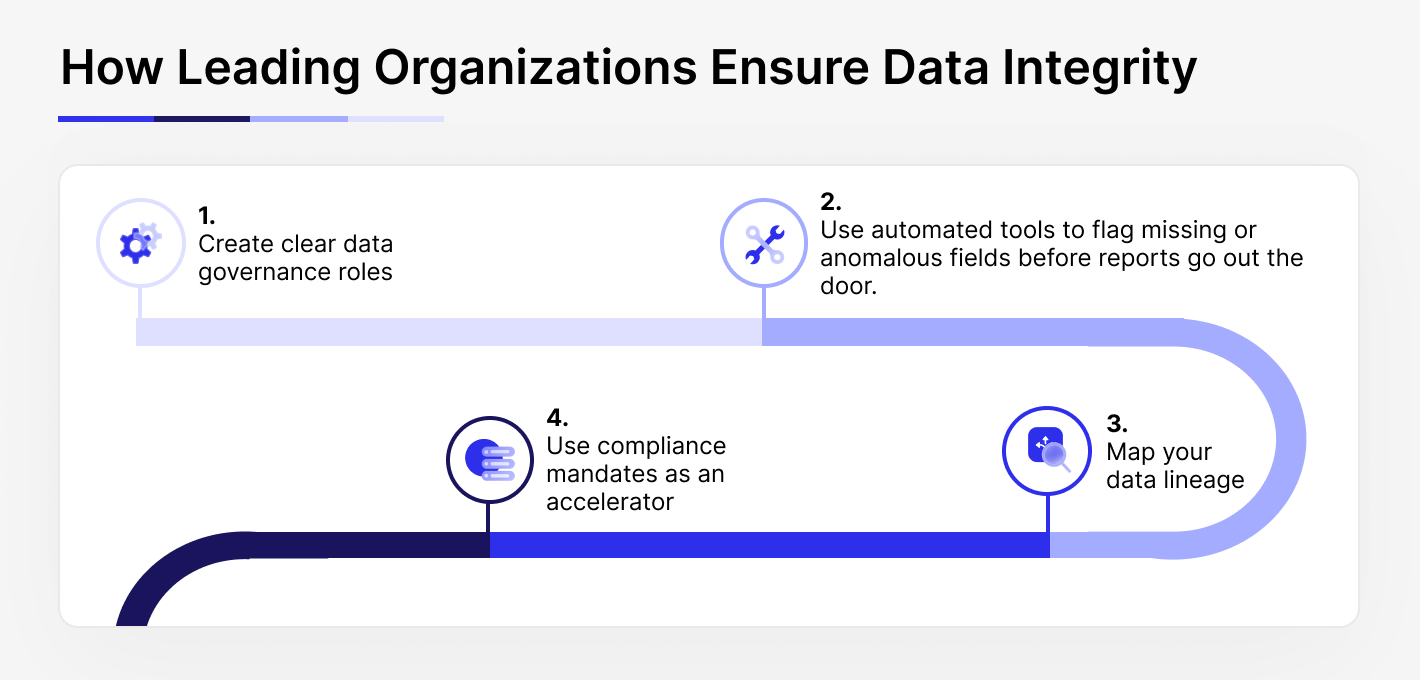
- Assign ownership: Create clear data governance roles. No more passing the buck.
- Validate before submission: Use automated tools to flag missing or anomalous fields before reports go out the door.
- Map your data lineage: Know exactly where each data point comes from and how it flows through your systems.
- Use compliance mandates as an accelerator: When regulation demands better data, don’t resist — use it as a reason to clean house.
As one regulatory expert put it: “Today, regulators don’t just want to know what happened — they want to know how you know it happened.” So, if your data isn’t complete, accurate, and centralized, your compliance risk goes up — fast.
At Sombra, we prefer to say that good data governance is good compliance, and good compliance is good business.
Step 3: Streamlining Client Reporting Through Integrated Data
If there’s one place where all your data challenges come home to roost, it’s client reporting. High-net-worth and institutional clients expect timely, accurate, complete pieces that give a holistic view of their wealth. The only way to produce client reports is through integrated data. Across all accounts. In the client’s preferred format. On time.
But behind that report is chaos.
Most wealth and asset managers are still stitching together data from dozens of sources — custodians, portfolio systems, trading desks, CRM tools, and legacy spreadsheets. Some firms are managing relationships with 60+ custodian banks globally, each with its own login portal, file format, and data definitions.
No wonder 83% of financial institutions say they lack real-time access to data due to fragmentation. Even more worrying? A survey by WealthArc found that wealth managers spend up to 70% of their time just gathering and reconciling data — instead of analyzing it or advising clients.
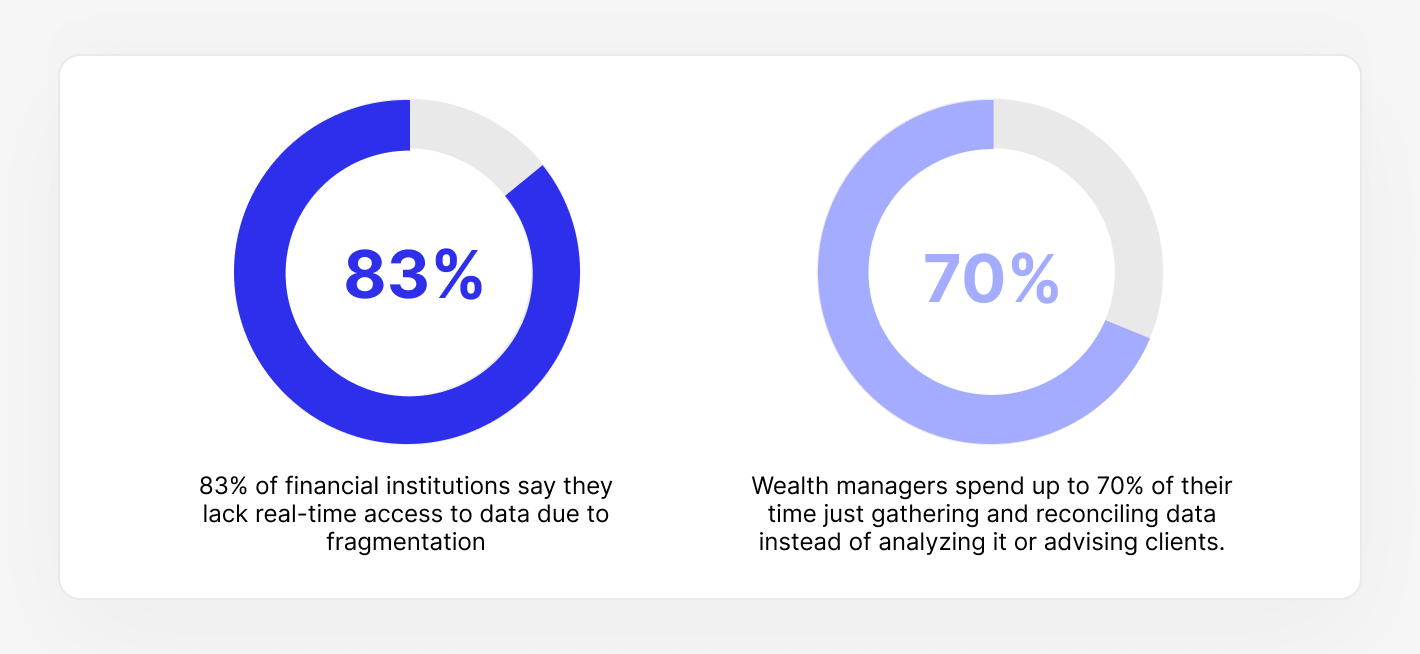
Where it breaks down:
- Multiple custodians = multiple headaches. Each uses different formats and naming conventions. “Intl. Equity” in one becomes “Non-US Stock” in another. Dates, currencies, and asset labels all vary — making standardization a daily grind.
- Manual data consolidation = human error. Many companies still copy and paste data into Excel. This process is slow, fragile, and nearly impossible to scale. One accidental overwriting of a formula can result in clients seeing incorrect numbers.
- Asynchronous updates = inaccurate snapshots. Data sources update at various intervals. You may obtain one account’s balance from yesterday and another from last week, which can make your “consolidated” report misleading.
- Data sprawl = internal friction. Portfolio teams, CRM managers, and compliance officers each store their version of the truth. Without integration, everyone’s working from different playbooks.
But here’s the good news: it’s fixable.
One of our clients was having difficulty combining public data from NASS, USDA, and NAV with their internal records. Insights were scattered across various tools, and decisions were being made without having the complete picture.
We stepped in to build a unified data platform using Apache Spark and Amazon EWR. The solution included automated calculations, stakeholder-specific views, and streamlined reporting. Shortly, the client saw a 70% increase in customer satisfaction.
Reports are now available in two main formats. The first format includes pre-built business intelligence (BI) reports, which are developed by engineers, thoroughly tested, and fully automated. Automation manages everything from scheduled data refreshes across multiple sources to email-based report delivery. The second format consists of flexible ad hoc reports. By utilizing pre-tested, reliable datasets, we have significantly reduced the time required to build data marts, making it quicker and easier to access trustworthy data for on-the-spot analysis.
Better access leads to better insights — and better decisions. That’s what builds stronger collaboration with investors. And it all starts with one thing: a reliable source of truth.
Some firms are taking a similar path with data lakes for raw intake and reporting engines that generate and personalize reports on the fly. These setups support custom styling, segmentation, and scheduling — so you can send a quarterly PDF to one client and offer a real-time dashboard to another.
Why this matters more than ever:
- Clients expect personalized, transparent, and on-demand reporting — especially high-net-worth individuals with complex portfolios.
- Regulators increasingly scrutinize reporting accuracy — especially for advisory accounts and multi-asset structures.
- Competitors are moving fast. A mid-size firm with smart data infrastructure can now deliver family office-level reporting — and win business from larger, slower players.
And let’s not forget the soft power of great reporting: trust.
When your client gets a consolidated, error-free, on-time report, it reinforces confidence. They feel seen. Understood. Like someone is truly in control of their wealth. On the other hand, a messy or delayed report makes clients question everything — your systems, your insights, your service.
So, what are leading firms doing?
They’re shifting from “assemble and reconcile” to “connect and serve.”
Here’s what that looks like:
- One integration layer for all data feeds — custodians, platforms, internal systems.
- Data mapping and transformation tools that normalize fields (no more “Intl. Eq.” vs. “Non-US” fights).
- Central data models that feed CRM, reporting, analytics, and compliance from the same source.
- Automation tools to generate, QA, and distribute reports without human error.
- Cloud-native infrastructure that scales with data volume and enables global access.
Sombra helps clients deploy exactly this kind of integrated stack — combining enterprise-grade data warehousing with intuitive reporting interfaces that advisors and ops teams actually enjoy using. As one client put it:
“We didn’t just fix reporting. We fixed our whole view of the client.”
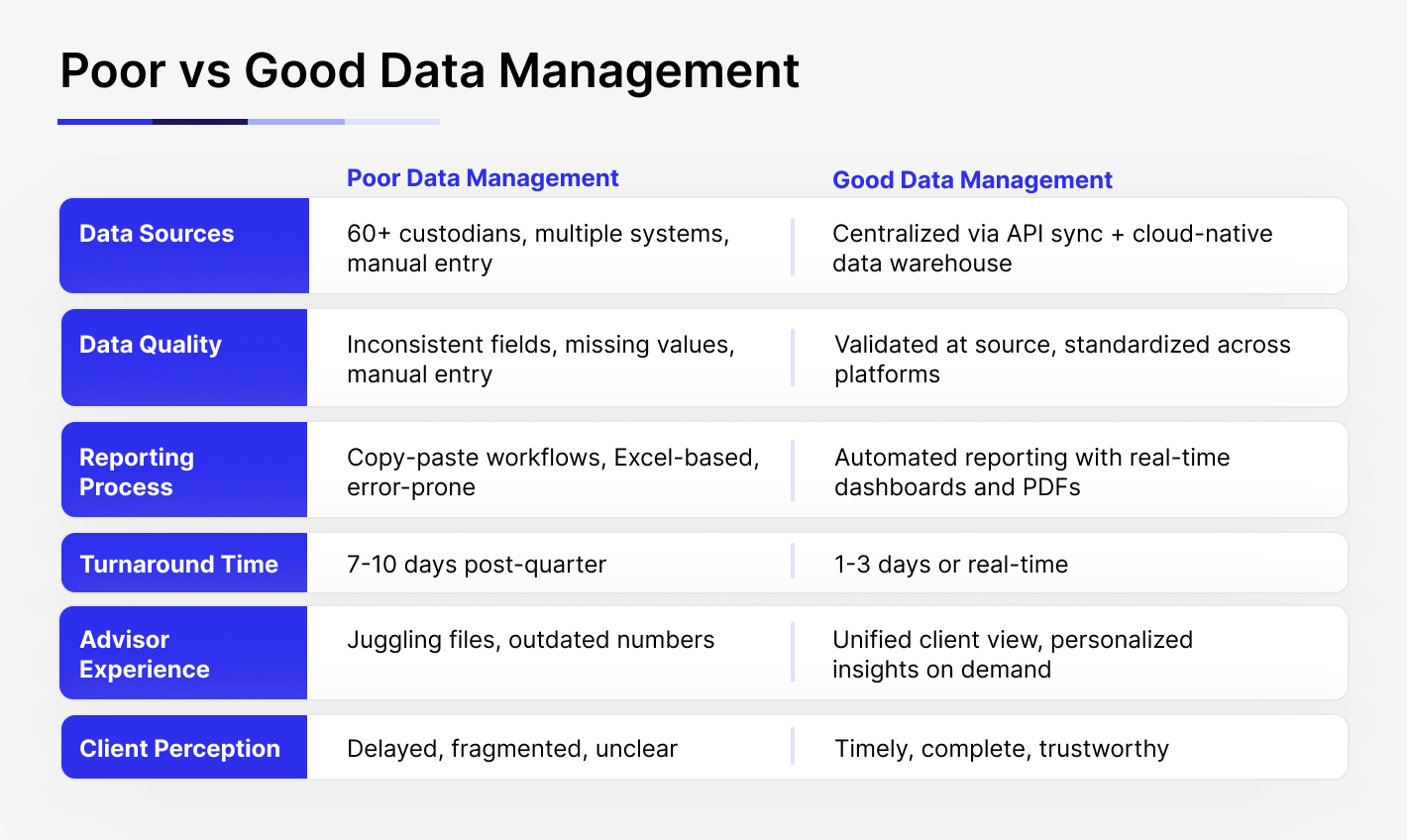
The Kick-Off for W&A Company
So we’ve recognized the problem: scattered data, time-consuming reporting, risky compliance gaps, and teams bogged down in reconciliation instead of strategy. Now comes the question: Where do we even begin?
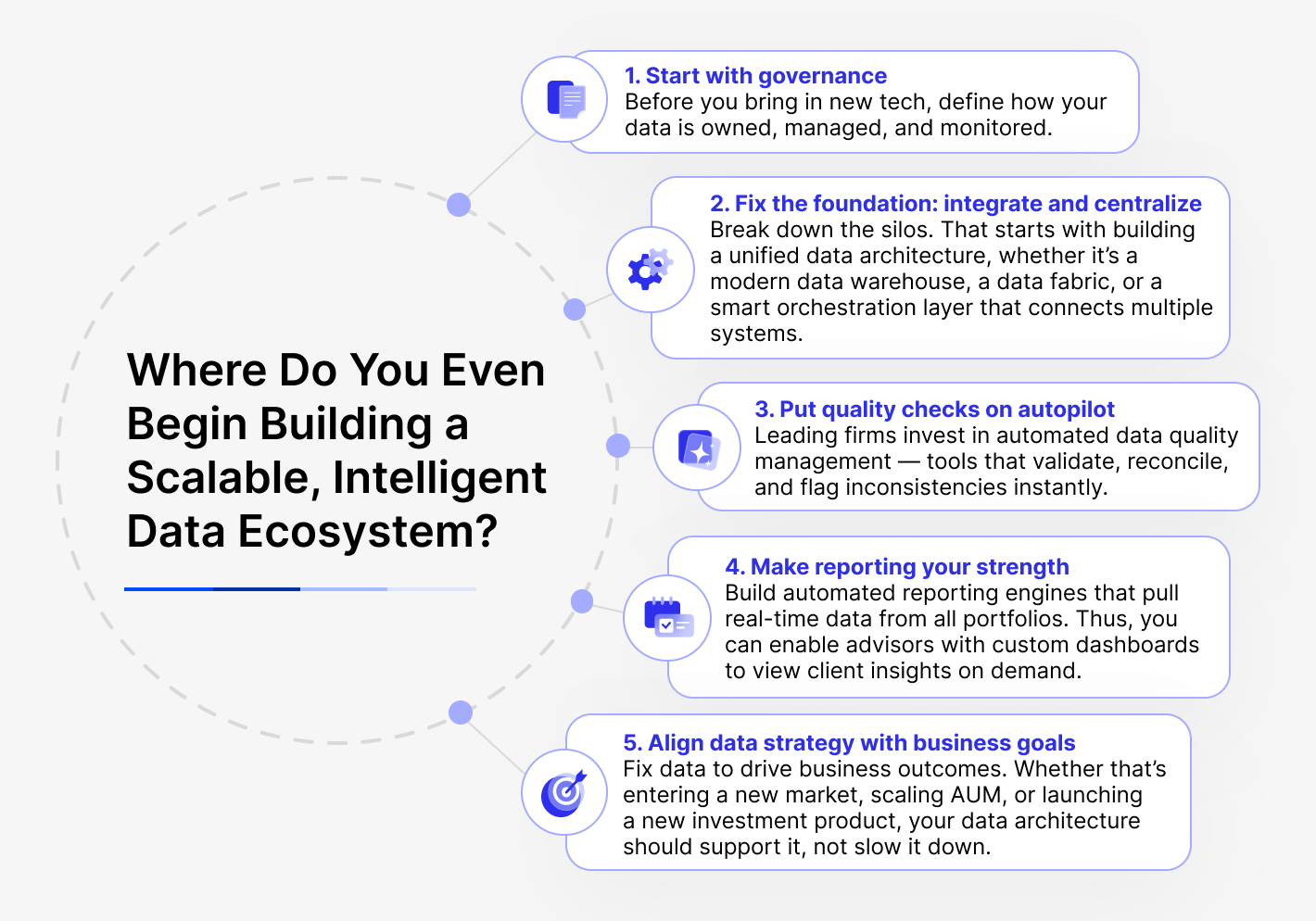
This is the kick-off moment – the shift from reactive to proactive. We are moving from putting out fires to building a scalable, intelligent data ecosystem that truly fuels performance rather than frustrates it. Here’s our vision for the journey of a smart Wealth and Asset Management Organization.
1. Start with Governance, Not Just Tools
Before you bring in new tech, define how your data is owned, managed, and monitored. That means clear roles (data stewards, owners, custodians), consistent naming conventions, validation rules, and a culture that values clean data as much as clean portfolios.
What this looks like in practice:
- A single source of truth for client data, not 5 overlapping records.
- Automated checks to flag when something doesn’t add up (e.g., mismatched identifiers or missing trade timestamps).
- A clear process to fix issues before they snowball into client errors or compliance fines.
As Deloitte puts it, “Without data governance, financial institutions are flying blind.” You’re not just missing efficiency — you’re introducing unnecessary risk.
2. Fix the Foundation: Integrate and Centralize
Your next step is to break down silos. This begins with creating a unified data architecture. Whether you choose a modern data warehouse, a data fabric, or a smart orchestration layer that links multiple systems, the objective remains the same: ensure that every team is working from the same information.
Firms that do this well:
- Replace spreadsheets and emails with real-time data pipelines.
- Migrate from on-prem databases to scalable, secure cloud platforms.
- Consolidate data feeds from Bloomberg, Refinitiv, Morningstar, and internal systems into a single ecosystem — no more manual merges.
Sombra’s take: We help W&A firms make this shift without slowing down business. That means building API-based data pipelines, deploying cloud-native warehouses, and ensuring compatibility across all systems — from CRM to risk analytics to reporting.
3. Put Quality Checks on Autopilot
No one wants to QA trades manually. That’s why leading firms invest in automated data quality management — tools that validate, reconcile, and flag inconsistencies instantly.
Use AI to:
- Catch anomalies in trade records or client data.
- Automatically fill in missing values when rules allow.
- Monitor the health of your data across systems with real-time alerts.
Why it matters? As we already mentioned, data quality can cost financial firms $15M annually on average — and that’s before considering the lost opportunities tied to bad insights.
4. Make Reporting a Strength, Not a Struggle
Instead of scrambling each quarter, your team can generate personalized, accurate reports at scale — in minutes. That’s the power of integrating your reporting stack with your data foundation.
- Build automated reporting engines that pull real-time data from all portfolios.
- Enable advisors with custom dashboards to view client insights on demand.
- Give clients what they expect: consolidated, intuitive, and timely reports.
5. Align Data Strategy With Business Goals
This is the step that ties it all together.
Don’t fix data just for the sake of fixing it. Focus on fixing data to achieve specific business outcomes. Whether you’re entering a new market, increasing assets under management (AUM), or launching a new investment product, your data architecture should facilitate these goals rather than hinder them. Make sure to ask:
- Can your current systems support more clients without adding more headcount?
- Can your data flows keep up with changing regulations?
- Can your advisors deliver hyper-personalized insights at scale?
If not, it’s time for a rethink.
Here’s a brief strategy table summarizing key actions and their benefits:
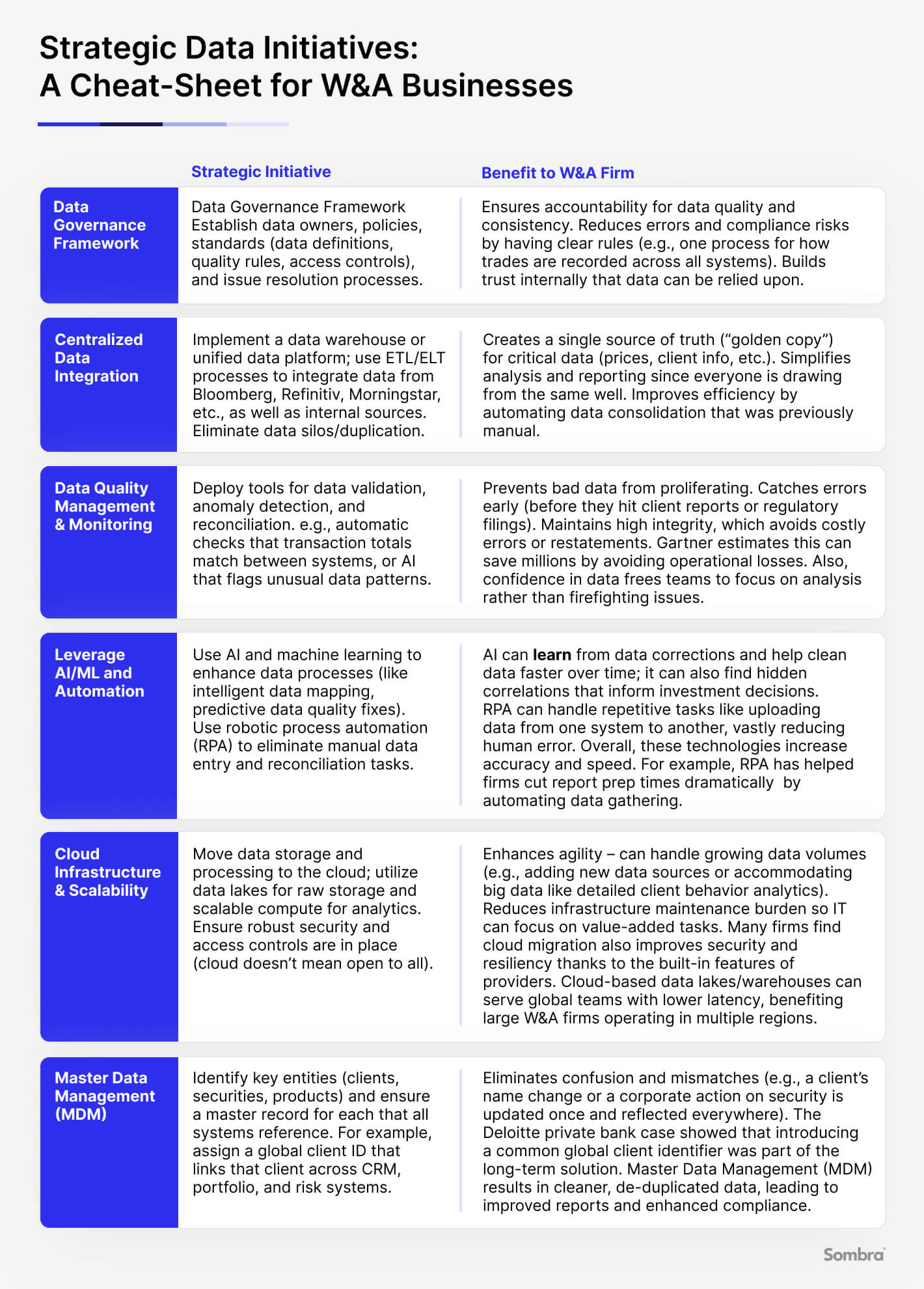
Final Step: Turn Your Data Into a Strategic Advantage
Data is your edge. The firms winning in wealth and asset management today aren’t the ones with the most systems. They’re the ones with the cleanest data, the clearest insights, and the fastest decisions. If you’re still stuck reconciling spreadsheets, chasing errors, or second-guessing reports, you’re not just behind — you’re exposed.
It’s time to fix it.
Talk to Sombra. We’ll help you clean, integrate, and elevate your data so you can move faster, report smarter, and serve clients better.
Let’s turn complexity into clarity — and data into your advantage.
Ready to kick off? Let’s talk.











